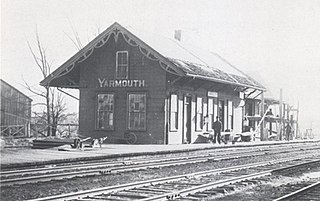
Ulmus americana, generally known as the American elm or, less commonly, as the white elm or water elm, is a species of elm native to eastern North America, naturally occurring from Nova Scotia west to Alberta and Montana, and south to Florida and central Texas, and is the State Tree of Massachusetts. The American elm is an extremely hardy tree that can withstand winter temperatures as low as −42 °C. Trees in areas unaffected by Dutch elm disease (DED) can live for several hundred years. A prime example of the species was the Sauble Elm, which grew beside the banks of the Sauble River in Ontario, Canada, to a height of 43 m (140 ft), with a d.b.h of 196 cm (6.43 ft) before succumbing to DED; when it was felled in 1968, a tree-ring count established that it had germinated in 1701.

The Wych Elm cultivar Ulmus glabra 'Camperdownii', commonly known as the Camperdown Elm, was discovered about 1835–1840 as a young contorted elm growing in the forest at Camperdown House, in Dundee, Scotland, by the Earl of Camperdown's head forester, David Taylor. The young tree was lifted and replanted within the gardens of Camperdown House where it remains to this day. The original tree, which grows on its own roots, is less than 3 m tall, with a weeping habit and contorted branch structure. The earl's gardener is said to have produced the first of what are commonly recognised as Camperdown elms by grafting a cutting to the trunk of a wych elm.

The Liberty Tree (1646–1775) was a famous elm tree that stood in Boston, Massachusetts near Boston Common in the years before the American Revolution. In 1765, Patriots in Boston staged the first act of defiance against the British government at the tree. The tree became a rallying point for the growing resistance to the rule of Britain over the American colonies, and the ground surrounding it became known as Liberty Hall. The Liberty Tree was felled in August 1775 by Loyalists led by Nathaniel Coffin Jr. or by Job Williams.

The Meadows is a large public park in Edinburgh, Scotland, to the south of the city centre.

State Route 88 (SR 88) is a state highway in southern Maine, United States. It runs south to north for 8.37 miles (13.47 km), from U.S. Route 1 (US 1) in Falmouth to US 1 in Yarmouth. It runs to the east of US 1, and its speed limit is 35 miles per hour (56 km/h). Over its course, its furthest distance from US 1 is about 1⁄2 mile (0.80 km). This occurs in its Falmouth Foreside section.
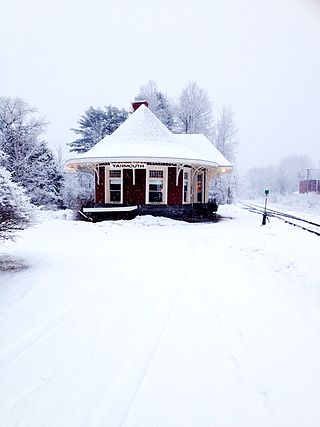
Yarmouth station of Yarmouth, Maine, is located on the east side of the railroad tracks, just south of Maine State Route 115, the town's Main Street. The railroad station was built in 1906 by the Grand Trunk Railroad, and is a well-preserved example of an early 20th-century passenger rail depot, an increasingly rare sight in the state. The building, which is now in commercial use, was added to the National Register of Historic Places on July 10, 1979.

Yarmouth is a town in Cumberland County, Maine, United States, twelve miles north of the state's largest city, Portland. When originally settled in 1636, as North Yarmouth, it was part of the Massachusetts Bay Colony, and remained part of its subsequent incarnations for 213 years. In 1849, twenty-nine years after Maine's admittance to the Union as the twenty-third state, it was incorporated as the Town of Yarmouth.
The historical buildings and structures of Yarmouth, Maine, represent a variety of building styles and usages, largely based on its past as home to almost sixty mills over a period of roughly 250 years. These mills include that of grain, lumber, pulp and cotton. Additionally, almost three hundred vessels were launched by Yarmouth's shipyards in the century between 1790 and 1890, and the homes of master shipwrights and ship captains can still be found throughout the town.

The Shelton Oak, also known as Owen Glendwr's Observatory or the Glendower Oak, was a veteran oak tree near Shrewsbury, England. It may be the "grette Oak at Shelton" mentioned in a document from the time of Henry III (1216–1272). The oak is said to have been climbed by Owain Glyndŵr to view the 1403 Battle of Shrewsbury, from which its alternative name derives. In later years the tree became renowned for its hollow trunk which was variously described as able to accommodate twenty people, six people sitting for dinner or an eight-person quadrille dance. The tree had fallen by 1940 and its remains were removed in the 1950s to facilitate improvements to an adjacent road junction.

Down-East Village Restaurant & Motel was a business that existed in Yarmouth, Maine, from 1950 to 2011. It was the second motel built in Maine, and eventually became the oldest in operation.

Frank Addison Knight was an arborist from Yarmouth, Maine, United States. One of his most prominent roles was as the tree warden for "Herbie", an American elm that stood in Yarmouth for over 200 years. It was a role he held for around the last fifty years of the tree's life. "Herbie" was the oldest and largest American elm in New England. The tree was cut down in 2010 after succumbing to Dutch elm disease. Knight's efforts to extend the tree's life brought him international attention. He estimated he saved the tree's life on fourteen occasions over five decades. "It's his time now, and soon it will be mine," a 101-year-old Knight said, attending the tree's removal on January 19, 2010.

Main Street is a historic street in Yarmouth, Maine, United States. It is part of the 18-mile-long (29 km) State Route 115 (SR 115), the eastern terminus of which is in Yarmouth at the intersection of Marina Road and Lafayette Street (SR 88), at Yarmouth Harbor in the Lower Falls area. Its western end is a merging with Walnut Hill Road in North Yarmouth, at which point SR 115 continues west.
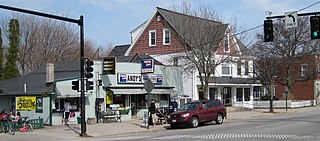
Andy's Handy Store, colloquially known as Handy Andy's, is a historic building in Yarmouth, Maine, United States. Located at 367 Main Street, at its junction with Elm Street in the town's Upper Village, part of the building dates to 1891. It has been the home to over thirty businesses. As of early 2022, Thoroughfare occupies the entire building.
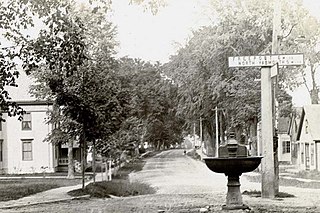
Elm Street is a prominent street in Yarmouth, Maine, United States. It runs for about 2.7 miles (4.3 km) from North Road in the north to Portland Street in the south. The street's addresses are split between "West Elm Street" and "East Elm Street", the transition occurring at Main Street in the Upper Village. Several of its buildings are homes dating to the late 18th and early 19th centuries.

Portland Street is a historic street in Yarmouth, Maine, United States. It runs for about 1.25 miles (2.01 km) from the town's Main Street, State Route 115, in the north to its merge with Middle Road in the south. It is so named because it leads to Portland, the state's largest city, after linking up with State Route 9 in Falmouth, Maine.
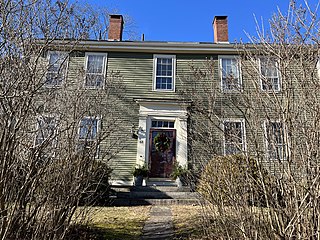
68 East Main Street is a historic home in Yarmouth, Maine, United States. It was built in 1785, when the town was part of North Yarmouth, around seventy years after the "third, and earliest permanent, settlement" of the town.

Princes Point Road is a prominent street in Yarmouth, Maine, United States. It runs for about 1.93 miles (3.11 km) from Lafayette Street in the north to Sunset Point Road in the south. It was one of the first streets laid out in the town when it was centered around the Meetinghouse under the Ledge in the 18th century. Gilman Road, another of the early roads in the area, intersects Princes Point Road near its northern end.

The Beth Condon Memorial Pathway is a recreation path in Yarmouth, Maine, United States. It is named in memory of 15-year-old Yarmouth High School sophomore Beth Condon, who was killed by drunk driver Martha Burke in 1993 as she walked along U.S. Route 1 with her boyfriend, James Young, having just been to a video store in Yarmouth Marketplace. Burke's car swerved into the breakdown lane, and while Young managed to avoid the car, Condon was hit and thrown 65 feet (20 m) over the guardrail and down an embankment. Burke pleaded guilty to manslaughter and was sentenced to twelve years, with eight years suspended.





















